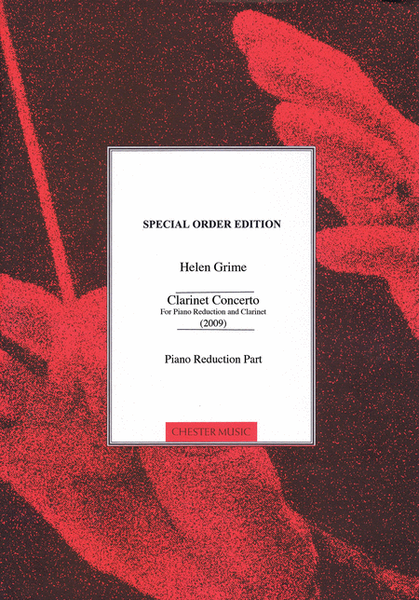Clarinet Concerto
Clarinet and Piano Reduction
Details
Description
SKU: HL.14041746
Clarinet and Piano Reduction. Composed by Helen Grime. Music Sales America. Classical. Softcover. Composed 2011. 29 pages. Chester Music #CH77880. Published by Chester Music (HL.14041746).UPC: 884088692681. 8.5x11.0x0.136 inches.
For solo Clarinet in Bb and Ensemble.
Clarinet and Piano Reduction.
Commissioned by the Tanglewood Music Center, through the generous support of the Mervyn Geffen M.D. and Norman Solomon M.D. New CommissionsFund.
First performance by Brent Besner, Clarinet, and fellows of the Tanglewood Music Center, August 2010.
1. With Vigour
2. Free and Enigmatic
3. Calmo
There is usually some sort of extra-musicalstarting point for my pieces, and for the Clarinet Concerto this was 'The Cracked Bell' by Baudelaire. In a short space of time the work seemed to take over and move further away the original stimulus, with the character andinteractive roles of the soloist and ensemble were suggested by the wintry, evocative atmosphere of the poem.
The piece opens with declamatory, cadenza-like passages in the clarinet that are in turn commented on by theensemble. A more playful section, where the clarinet line is very virtuosic, leads to a long, gently-unfolding melody in the ensemble that begins in the depths of the bass register and gradually gets much higher. Virtuosicclarinet lines interject against the accompaniment, and both pursue their own course until culminating in a high, impassioned melody for the clarinet, coloured by fast-moving passage work in the higher registers of ensemble. Themovement ends with the 'call and response' lines of its opening.
The second movement opens with an extended solo for the clarinet in its haunting chalumeau register. With each rising phrase, the clarinet line gets higheruntil the ensemble enters in unison. The movement becomes much faster and energetic from this point, with brisk, fleeting lines for soloist and ensemble.
The third movement is the most reflective of the three. It opens witha flute solo leading to the solo clarinet line, and makes much of the poignant singing style which is so characteristic of the instrument. A melancholy falling passage in the ensemble becomes a recurring feature before the.
Song List (1)
- Clarinet Concerto

 Share
Share